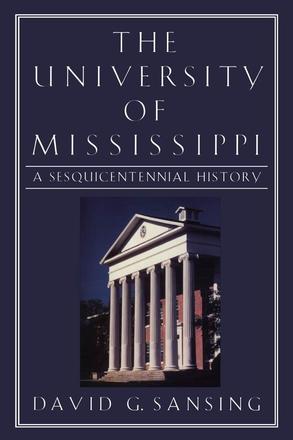
The University of Mississippi
A Sesquicentennial History
Description
"There is a mystique about Ole Miss," David G. Sansing says in his new book The University of Mississippi: A Sesquicentennial History (University Press of Mississippi, cloth $37. 00).
Sansing, a professor emeritus of history, says the University and its story hold a special attraction for those who have learned there. "Some have called it holy ground, others hallowed ground. During a recent Black Alumni Reunion Danny Covington called Ole Miss addictive. "
Few Southern institutions have such a storied past. After its founding, the University assembled one of the finest scientific collections in the antebellum South. Closed during the Civil War, the University endured and re-opened to expand from a liberal arts institution to one with highly developed professional schools. In the civil rights struggle Ole Miss became a battleground. Since 1963 the University has made remarkable progress in serving the racial and ethnic diversity of its constituency.
Working with the university libraries, the Department of Archives and History, and countless alumni, Sansing unfurls this 150-year history in The University of Mississippi, a book he labored on since 1995.
Capturing dramatic changes was key to Sansing's efforts. The University that began with four professors and boasted electric power in 1901 is now listed by the internet site Yahoo! as one of the nation's most "wired" universities, referring to the University's level of hardware and internet access.
African American historian John Hope Franklin, who had visited the campus during the civil rights struggle, visited again in 1998 and found "a complete revolution in race relations on campus" and declared, "we don't have quite as far to go as we thought we did. "
Sansing says, "In a world of ravishing change, when Ole Miss Alumni come back to Oxford, they do not just stroll across the campus and through the Grove, they retrace the steps of their forebears, not just over place and space, but back through time as well.
"For many alumni Ole Miss is more than their alma mater; it is a link, a nexus to who they were and are, to where they came from," Sansing says. "This sesquicentennial history is written for them, the students, faculty, friends, patrons, and alumni of the university. "
"There is a mystique about Ole Miss," David G. Sansing says in his new book The University of Mississippi: A Sesquicentennial History (University Press of Mississippi, cloth $37. 00).
Sansing, a professor emeritus of history, says the University and its story hold a special attraction for those who have learned there. "Some have called it holy ground, others hallowed ground. During a recent Black Alumni Reunion Danny Covington called Ole Miss addictive. "
Few Southern institutions have such a storied past. After its founding, the University assembled one of the finest scientific collections in the antebellum South. Closed during the Civil War, the University endured and re-opened to expand from a liberal arts institution to one with highly developed professional schools. In the civil rights struggle Ole Miss became a battleground. Since 1963 the University has made remarkable progress in serving the racial and ethnic diversity of its constituency.
Working with the university libraries, the Department of Archives and History, and countless alumni, Sansing unfurls this 150-year history in The University of Mississippi, a book he labored on since 1995.
Capturing dramatic changes was key to Sansing's efforts. The University that began with four professors and boasted electric power in 1901 is now listed by the internet site Yahoo! as one of the nation's most "wired" universities, referring to the University's level of hardware and internet access.
African American historian John Hope Franklin, who had visited the campus during the civil rights struggle, visited again in 1998 and found "a complete revolution in race relations on campus" and declared, "we don't have quite as far to go as we thought we did. "
Sansing says, "In a world of ravishing change, when Ole Miss Alumni come back to Oxford, they do not just stroll across the campus and through the Grove, they retrace the steps of their forebears, not just over place and space, but back through time as well.
"For many alumni Ole Miss is more than their alma mater; it is a link, a nexus to who they were and are, to where they came from," Sansing says. "This sesquicentennial history is written for them, the students, faculty, friends, patrons, and alumni of the university. "